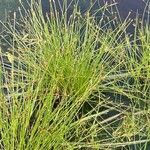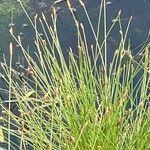Perennial, with capillary stolons usually forming dense mats. Stems erect, capillarv, angular-sulcate (usually 4-angled), smooth, 3-10(-30)cm by 1/6-¼(-½) mm, often much elongated in deep or running water. Sheaths thinly membranous, loose, oblique at the mouth, often reddish at the base, the apex scarious and often somewhat inflated. Spikelet ovate to lanceolate, more or less flattened, acute, (3-)5-8(-15)-flowered, 2-4(-7) by 1-1½ mm. Glumes thinly membranous, suberect, oblong-ovate, obtusish, 1-nerved, pale green with scarious margins and often reddish brown sides, 1½-2 by 1-1½ mm, the lower ones subdistichous. Bristles up to 4, very slender, equalling or exceeding the nut, often reduced or absent (see note). Stamens 2-3; anthers linear, 3/5-1 mm; connective shortly produced. Style 3-fid. Nut very obtusely trigonous, almost terete, obovate-oblong, on each face with 2-4 distinct longitudinal ribs connected by numerous transverse cross-ridges, whitish to light brown, ¾-1 by 2/5-½ mm; epidermal cells transversely linear. Style-base minute, depressed pyramidal, ⅓-½ as wide as the nut.
Diminutive, very slender perennial, commonly forming dense tufts on slender rhizomes; stems 3–12 cm, filiform, up to 0.25 mm thick; spikelet 2.5–7(–9) mm, 3–15-fld; scales (1.3–)1.5–2.2 mm, with a greenish midrib and ± hyaline, paler or partly anthocyanic margins, the basal one floriferous; bristles mostly 3 or 4, equaling or surpassing the achene, or reduced or obsolete; anthers 0.7–1.3 mm (dry); style trifid; achene white to pale gray or faintly yellowish, 0.7–1 mm, rounded-trigonous, longitudinally 8–18-ribbed and with very numerous fine, straight cross-ridges; tubercle short, ± triangular-conic; 2n=20–58. Marshes, muddy shores, and other wet places; circumboreal, s. to Fla. and Mex.



